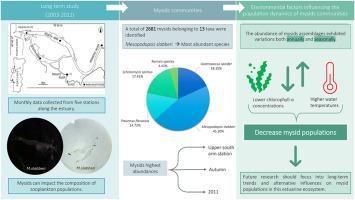伊比利亚西北部河口糠虾群的变化和组成:从 10 年数据系列中获得的启示
IF 2.6
3区 地球科学
Q1 MARINE & FRESHWATER BIOLOGY
引用次数: 0
摘要
长期的时间研究被用来评估气候变化对糠虾种群的影响以及它们在异质生态系统中复杂的生态相互作用。本研究首次对葡萄牙西部蒙德戈河口的糠虾群落进行了调查,时间跨度为 2003 年至 2012 年的十年。从河口沿岸五个站点收集的月度数据用于研究糠虾群落的组成、模式、物候变化以及与环境变量的相互作用。在组合中发现了 13 个分类群。该群落以 Mesopodopsis slabberi 为主,在河口上游地区发现了大量的 Mesopodopsis slabberi。Praunus flexuosus 和 Schistomysis spiritus 在河口中部的组合中占主导地位,而 Gastrossacus spinifer 和 Heteromysis formosa 则在河口非常丰富。总体而言,糠虾主要出现在秋季,当地的环境因素(如水温和叶绿素-a 浓度)影响了它们的数量。该系统的高生产力对提高物种丰度起到了关键作用。然而,在温度较高的年份,物种丰度较低,这进一步证明了在未来水温升高的气候情景下,这些关键物种群落的变化。本文章由计算机程序翻译,如有差异,请以英文原文为准。

Variability and composition of mysid assemblages in a northwest Iberian estuary: Insights from a 10-year data series
Long-term temporal studies have been used to assess the effects of climate change on mysid populations and their complex ecological interplay within heterogeneous ecosystems. This study is the first to investigate the mysid community in the Mondego estuary, western Portugal, for a decade, from 2003 to 2012. Monthly data collected from five stations along the estuary was used to investigate variations in mysid assemblage composition, patterns, phenology, and the interactions with environmental variables. Thirteen taxa were found in the assemblages. The community was dominated by Mesopodopsis slabberi, which was found in great numbers in the upper estuarine region. Praunus flexuosus and Schistomysis spiritus dominated the assemblages in the middle estuary, while Gastrossacus spinifer and Heteromysis formosa were very abundant at the mouth of the estuary. Overall, mysids were mostly present during autumn periods, when local environmental factors such as water temperature and chlorophyll-a concentrations influenced assemblage abundances. The high productivity of the system played a pivotal role in fostering greater species abundance. However, lower abundances were detected during warmer years, further evidencing changes in these key species’ communities under future climatic scenarios of increasing water temperatures.
求助全文
通过发布文献求助,成功后即可免费获取论文全文。
去求助
来源期刊
CiteScore
5.60
自引率
7.10%
发文量
374
审稿时长
9 months
期刊介绍:
Estuarine, Coastal and Shelf Science is an international multidisciplinary journal devoted to the analysis of saline water phenomena ranging from the outer edge of the continental shelf to the upper limits of the tidal zone. The journal provides a unique forum, unifying the multidisciplinary approaches to the study of the oceanography of estuaries, coastal zones, and continental shelf seas. It features original research papers, review papers and short communications treating such disciplines as zoology, botany, geology, sedimentology, physical oceanography.

 求助内容:
求助内容: 应助结果提醒方式:
应助结果提醒方式:


